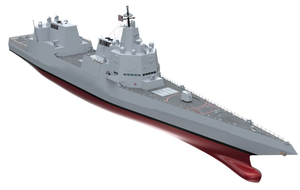Akira-Class Cruiser
 Rendering of the Akira-Class
| |
| Class overview | |
|---|---|
| Builders: | Norfolk Naval Shipyards |
| Operators: | Seylosian Royal Navy |
| Cost: | ca. $1 billion |
| Built: | 2021–present |
| In commission: | 2023-present |
| Planned: | 6 |
| Building: | 4 |
| Completed: | 1 |
| Active: | 1 |
| General characteristics | |
| Type: | Cruiser |
| Displacement: | 13,290 tons |
| Length: | 180 m (590 ft 7 in) |
| Beam: | 21.2 m (69 ft 7 in) |
| Propulsion: |
|
| Speed: | 32 kn (59 km/h) |
| Range: | 7,000 nautical miles (13,000 km) |
| Boats & landing craft carried: | WIP |
| Complement: | 250 (Accommodation for 350) |
| Sensors and processing systems: |
|
| Electronic warfare & decoys: |
|
| Armament: |
|
| Aircraft carried: | 2 × helicopters |
| Aviation facilities: | Enclosed Hangar |
The Akira Class is a Seylosian cruiser whose development first began in 2016. As Seylos began to rise in prominence both throughout Argis and Eurth, it was decided that Seylos would need a heavier ship class to be able to engage in possible large scale fleet battles. The Akira Class is considered a multi-role warship and was designed to support the force it was with in a multitude of ways, though it was primarily designed to fight other ships at sea.
History
Seylos's last cruiser vessel by class was the Montgomery Class, first built in 1959 as part of the Seylosian military's recovery post-Mandate. A total of six of these ships were constructed, with the last of these ships being decommissioned in 1993. During the 1990s, a series of budget cuts and economic difficulties forced lower spending within the military budget, and the older cruiser models were deemed the most expensive to maintain. By the early 2010s, the only new ship design to come from the Norfolk Naval Yards was the Eclipse-Class destroyer, and there was significant concern within the Royal Navy that Seylos was falling behind in naval technology and by 2013 a new commission had been started to figure out the next steps in Seylosian ship design.
This commission eventually settled on the Next Generation Naval Program, which included the request to design four new ships to meet the Royal Navy's needs in the future. This would include a frigate, corvette, an amphibious-cruiser hybrid and a cruiser: which would eventually become the Akira Class. In 2016 the Norfolk Naval Shipyard's Private/Public design partnerships had settled on the basic design of this new cruiser.
Design
In 2016 planning and design had been moved to full speed. Several contractors: such as TRAIL, Military Standard Corporation (MSC), and Next Generation Electronics and Wireless (NGEW) began designing the new systems that would be aboard not only the Akira Class but others in the Next Generation Naval Program as well. Several beginning designs were tested at the Adlantic Wave Simulator, a large facility located in Dunblane that is capable of generating and simulating various types of waves, and the candidates were whittled down to a catamaran and a more traditional hull design. By the end of the year, the catamaran design was rejected on the basis of increased complexity and costs while delivering few, if any additional benefits for a ship of its size.
